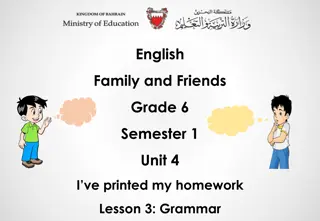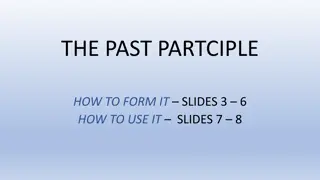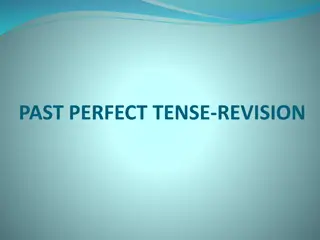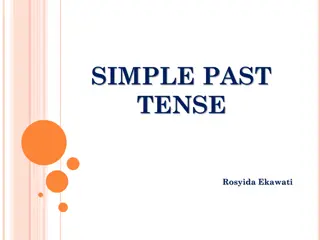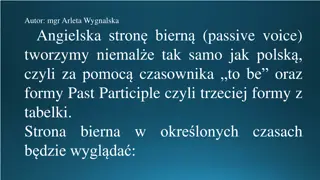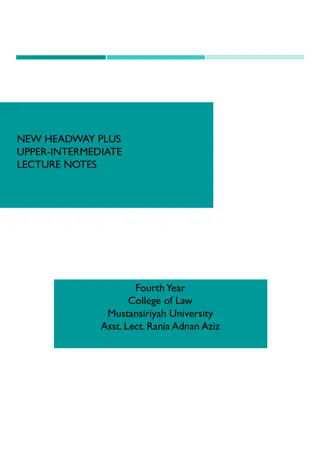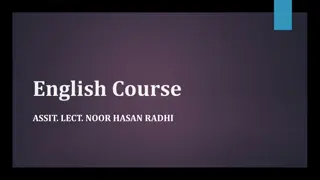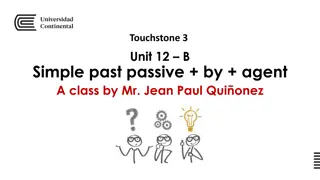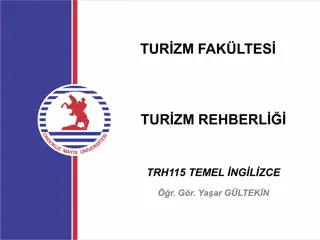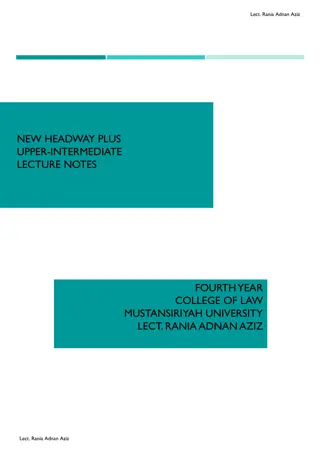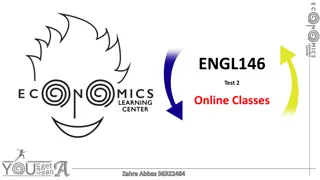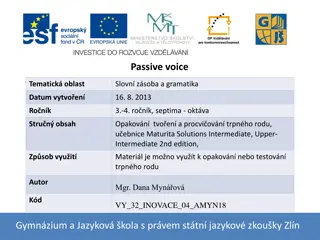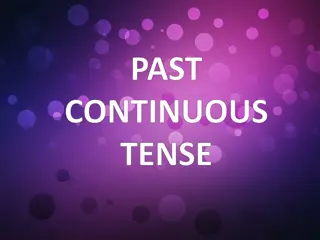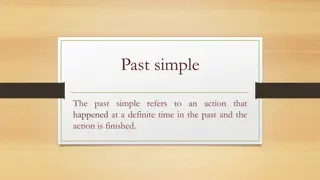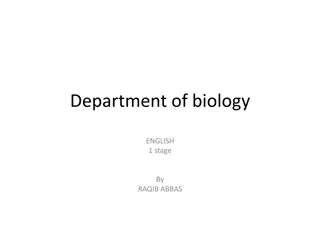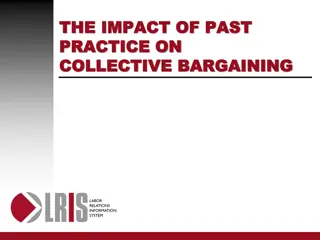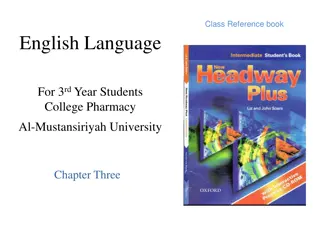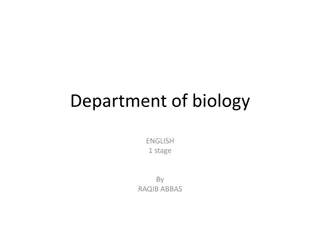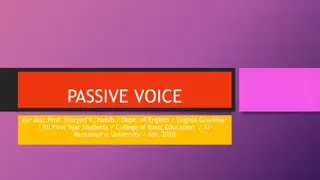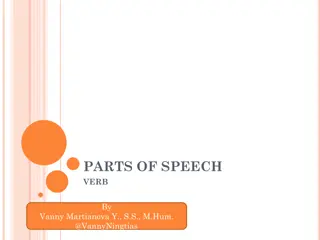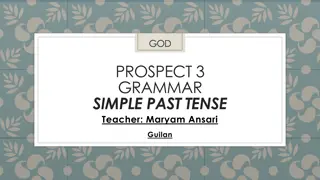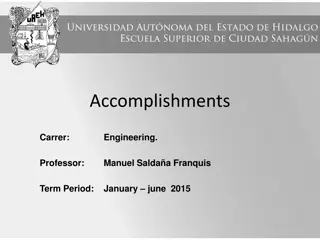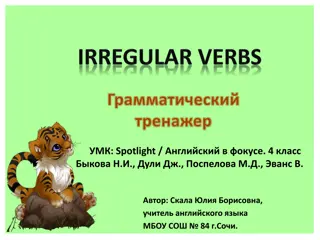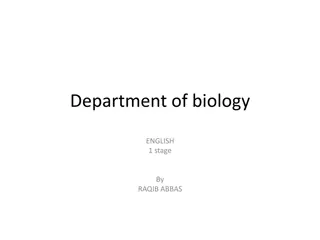Passive verb forms
Passive verb forms involve using "be" in a specific tense along with the past participle of a main verb to change the object of an active sentence into the subject of a passive sentence. The passive voice is commonly used in formal writing when the doer of the action is unknown, obvious, or purposel
2 views • 13 slides
Learn Past Continuous Tense - Grade 6 English Lesson
This Grade 6 English lesson focuses on understanding and correctly using the past continuous tense. It covers the rules for forming the past continuous tense, examples of its usage, and an assessment to test comprehension. Students will practice talking about actions happening at specific times in t
4 views • 6 slides
Learning Past Continuous Tense with Pronouns and Forming Questions
Explore how to use pronouns with "was" and "were" in the past continuous tense through examples and practice sentences. Learn to form questions using the past continuous tense and develop an understanding of when to use "was" or "were" with different subjects. Improve your grammar skills with this l
9 views • 15 slides
Learning Present Perfect in Yes/No Questions - Grade 6 English Grammar Lesson
Explore how to identify and use the present perfect tense in Yes/No questions through the engaging lesson on homework printing. Discover the structure and examples of asking and answering such questions correctly. Practice forming Yes/No questions using the present perfect tense with Cindy's chores.
14 views • 10 slides
Mastering the Past Participle in English Verbs
Understand how to form and use the past participle in English verbs, both regular and irregular. Learn the rules for forming regular past participles, including when to double consonants and when to change 'y' to 'i'. Discover examples of irregular verbs and how their past participles are formed. Ex
0 views • 8 slides
Understanding Past Tenses in Narratives
Exploring the use of past simple, past continuous, past perfect, and past perfect continuous tenses in narratives with examples and explanations. Learn how to convey different past events and their relationships in storytelling.
1 views • 4 slides
Learning to Tell Time in Minutes: Minutes Past the Hour
Explore how to tell the time in minutes past the hour by counting clockwise in intervals of five and then adding single minutes to find the exact time. Practice identifying time expressions like "quarter past" and "half past" as well as reading the time to the nearest minute.
0 views • 24 slides
Mastering the Past Perfect Tense: A Comprehensive Guide
Explore the intricacies of the past perfect tense through engaging examples of two different events at different times in the past, understanding how to form sentences correctly and use time expressions effectively. Dive into exercises to enhance your grasp of the past perfect tense.
0 views • 10 slides
Understanding Historical Research: Methods, Purposes, and Aims
Historical research involves investigating past events systematically to provide a dynamic explanation, interpretation, and understanding of the past. It aims to uncover unknown aspects, answer unexplored questions, and link past happenings to the present to enrich human culture and encourage interd
0 views • 20 slides
Understanding Simple Past Tense in English Grammar
Explore the usage of simple past tense through examples, irregular verbs, and regular verb forms. Learn how to form affirmative, negative, and question sentences in the past. Enhance your understanding of past actions and events with clear explanations and practice exercises.
1 views • 19 slides
Learn How to Form Passive Voice in English
Passive voice in English is formed using the verb "to be" and the Past Participle form of the verb. This article covers various tenses in passive voice with examples and images for better understanding.
2 views • 8 slides
Understanding Regular and Irregular Verbs in Simple Past Tense
Learn how to form the simple past tense with regular and irregular verbs. Regular verbs end in "-ed," while irregular verbs have unique past tense forms. Examples and images illustrate the differences, helping you master past tense verb usage effortlessly.
0 views • 11 slides
Understanding the Present Perfect Tense in English Grammar
The lecture notes explore the Present Perfect tense, highlighting its connection between past actions and their relevance in the present. It compares the Past and Present Perfect tenses, discussing the nuanced differences and providing examples for clarity. The document covers the usage of the Prese
0 views • 8 slides
Understanding the Past Perfect Tense in English Grammar
The Past Perfect Tense is used to talk about actions completed before a certain point in the past, emphasizing the sequence of events. This tense follows the structure of "had + past participle" and is crucial for expressing events that happened earlier than others in a narrative. Knowing how to for
0 views • 27 slides
Understanding Simple Past Tense and Passive Voice Formation
The provided content covers the usage of simple past tense to discuss past events and the formation of passive voice in English grammar. Examples and explanations are given, along with vocabulary exercises and an apology scenario. Learn about making past verbs negative, forming passive sentences, an
0 views • 5 slides
Understanding Passive Voice in English: Usage and Examples
Passive voice is used to shift the focus from the subject to the object in a sentence. The passive construction is formed with the verb "to be" in the appropriate tense followed by the past participle of the main verb. Learn when to use passive voice, how to indicate the agent using "by," and how ad
0 views • 6 slides
Understanding Simple Past Tense in English: Rules and Examples
The simple past tense is a fundamental form in Modern English used to describe past events. It involves regular verbs adding "-ed" and irregular verbs having different forms. The construction of the simple past helps distinguish it from other past tense forms like past perfect and past progressive.
0 views • 33 slides
Understanding Narrative Tenses: Past Simple, Present Perfect, and Past Continuous
Explore the nuances of narrative tenses through detailed lecture notes by Lecturer Rania Adnan Aziz. Learn the differences between Past Simple and Present Perfect, grasp the usage of Past Continuous, and understand the significance of Past Perfect in expressing past actions and timelines. Dive into
0 views • 6 slides
Understanding the Past Perfect Tense in English Grammar
The past perfect tense expresses actions that occurred before another action in the past, referring to time up to a point in the past. It is often used in reported speech and formal writing to indicate completed actions before a specific event. The past perfect progressive tense emphasizes the durat
0 views • 15 slides
Understanding Principal Parts of Regular Verbs and Practice Exercises
Explore the principal parts of regular verbs including present, present participle, past, and past participle forms. Understand how regular verbs form their past and past participle, practice exercises to identify verb forms in sentences, and learn about verb conjugation rules.
0 views • 6 slides
Understanding Verb Tenses: Present Perfect and Past Perfect Forms
Explore the usage of present perfect and past perfect verb forms to indicate relationships of time and cause. Present perfect verbs denote actions with undefined past timing but relevance to the present, while past perfect verbs describe events that occurred before another past event. Examples and e
0 views • 7 slides
Understanding the Present Perfect Tense in English Grammar
The present perfect tense in English grammar is a combination of the present tense and perfect aspect used to express past events with present consequences. It is formed using the auxiliary verb "have" and the past participle of the main verb. This tense is essential for indicating completed actions
0 views • 27 slides
English Grammar Practice: Conditional Sentences Type 3
Practice English grammar with a focus on conditional sentences type 3. The content includes examples and exercises to help improve understanding and usage of past perfect tense, conditionals, and past participle forms. Explore scenarios and complete sentences to enhance your skills in forming comple
0 views • 14 slides
Understanding Passive Voice: Rules and Examples
Passive voice is a grammatical construction used when the focus is on the action itself rather than the doer. It is formed by combining a form of "to be" with the past participle of a verb. This content explores the usage of passive voice in different tenses - present simple, present continuous, pas
0 views • 14 slides
Understanding the Past Continuous Tense
The Past Continuous Tense is used to describe interrupted activities that continued for a period in the past or things happening continuously in the past. Learn how to form affirmative, interrogative, and negative sentences in this tense with examples and images.
0 views • 12 slides
Understanding the Past Simple Tense in English Grammar
The past simple tense refers to actions that occurred at a specific time in the past and are now completed. This tense follows a specific rule where the subject is combined with a verb (regular or irregular) and a complement. Adverbs like "yesterday," "ago," and "last" are commonly used with past si
0 views • 9 slides
Understanding Past Simple Tense in English Grammar
The past simple tense is used to describe completed actions or events that happened at a specific time in the past. Regular verbs form the past simple by adding "-ed", while irregular verbs have unique past tense forms. The structure for negative and question forms involves the auxiliary verb "did".
0 views • 6 slides
Illustrated Irregular Verbs for Learning English Vocabulary
Explore a visual collection of irregular English verbs through engaging images. Each verb is paired with its past simple and past participle forms to aid in learning and memorization. Enhance your language skills with this creative approach to mastering irregular verbs.
0 views • 40 slides
Understanding the Impact of Past Practices on Collective Bargaining
Exploring the significance of past practices in interpreting, supplementing, and potentially contradicting contract language within the context of collective bargaining. Covering topics such as the definition of past practices, the duty to bargain, waivers of protest rights, and remedies for unlawfu
0 views • 35 slides
Understanding Verbs: Types and Forms in English Grammar
Verbs in English grammar play a crucial role in expressing actions and states. They can be classified into various types such as action verbs, linking verbs, main verbs, auxiliary verbs, transitive verbs, intransitive verbs, and phrasal verbs. Verbs have six forms including base form, infinitive, pa
0 views • 13 slides
Understanding Past Tenses in English for 3rd Year College Pharmacy Students
Dive into the intricacies of past tenses in English as you explore the nuances between past simple, past continuous, past perfect, and more. Test your grammar skills while learning to express events that occurred in the past, with a focus on practical application for students at Al-Mustansiriyah Uni
0 views • 25 slides
Understanding Passive Voice in Pennsylvania Dutch
Passive voice in Pennsylvania Dutch (PD) involves the subject of the sentence not performing the action but having the action done to them. PD uses forms of "waerre" and the past participle to form passive sentences. The presence of an agent in passive sentences is indicated using the dative preposi
0 views • 6 slides
Understanding Past Perfect Tense in English Grammar
Past Perfect Tense is used to denote actions that were completed before another action occurred in the past. It is formed using the auxiliary verb "had" followed by a past participle. Examples of affirmative, negative, and question forms are provided to illustrate usage. The tense helps in sequencin
0 views • 4 slides
Common Regular Verbs and Their Past Tenses
Common regular verbs and their past tenses are essential aspects of grammar learning. Past tense forms of verbs are used to indicate actions or states that have already occurred. Examples of regular verbs and their corresponding past tenses are provided in this content, along with spelling rules for
0 views • 17 slides
Understanding Passive Voice in English Grammar
Passive voice in English occurs when the subject receives the action of the verb. This involves changing the order of subject and object, using the auxiliary verb "to be" in the tense of the active voice, and adding the past participle of the main verb. Various tenses can be used in passive voice co
1 views • 5 slides
Understanding Verbs: Forms, Tenses, and Usage
Explore the world of verbs, including base form, infinitive, gerund, past participle, and past form. Learn common verbs and their variations through examples. Dive into modals and verb structures for a comprehensive understanding of how verbs function in sentences.
0 views • 26 slides
Understanding Simple Past Tense in Grammar
In this file, we delve into the concept of simple past tense in grammar. Through examples and explanations, you will learn how to use the simple past tense to talk about completed actions in the past. The structure, usage, and importance of simple past tense are covered extensively to enhance your u
0 views • 30 slides
Expressing Accomplishments in English: A Comprehensive Guide
Learn how to express accomplishments in English using the verb "have/has" and past participle verbs. This guide covers affirmative, negative, and interrogative forms, along with differentiating between "since" and "for" when indicating duration. Master the language nuances for talking about achievem
0 views • 14 slides
Irregular Verbs: A Handy Guide to Commonly Used English Verbs
An overview of irregular verbs in English, including common examples of irregular verbs and their past participle forms. The content also includes images illustrating the verbs in different forms, making it easier to understand and remember irregular verb patterns. Helpful for English learners and a
0 views • 6 slides
Understanding the Past Continuous Tense in English Grammar
Past Continuous Tense is used to describe ongoing actions in the past. It is formed with "was/were" + present participle (-ing). Learn its structure, usage, negation, and questioning forms with examples. Enhance your English grammar skills by mastering the Past Continuous Tense.
0 views • 4 slides



